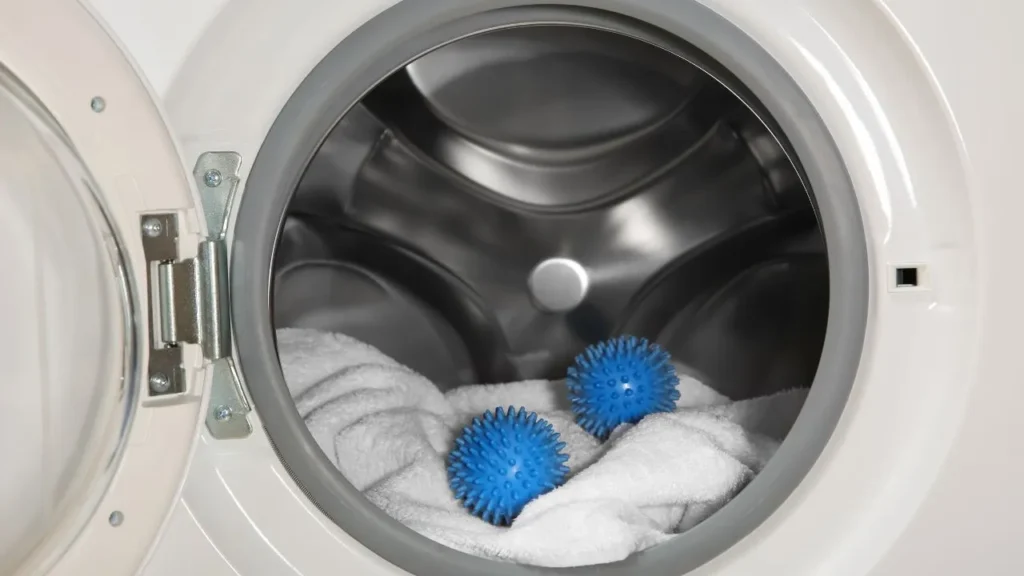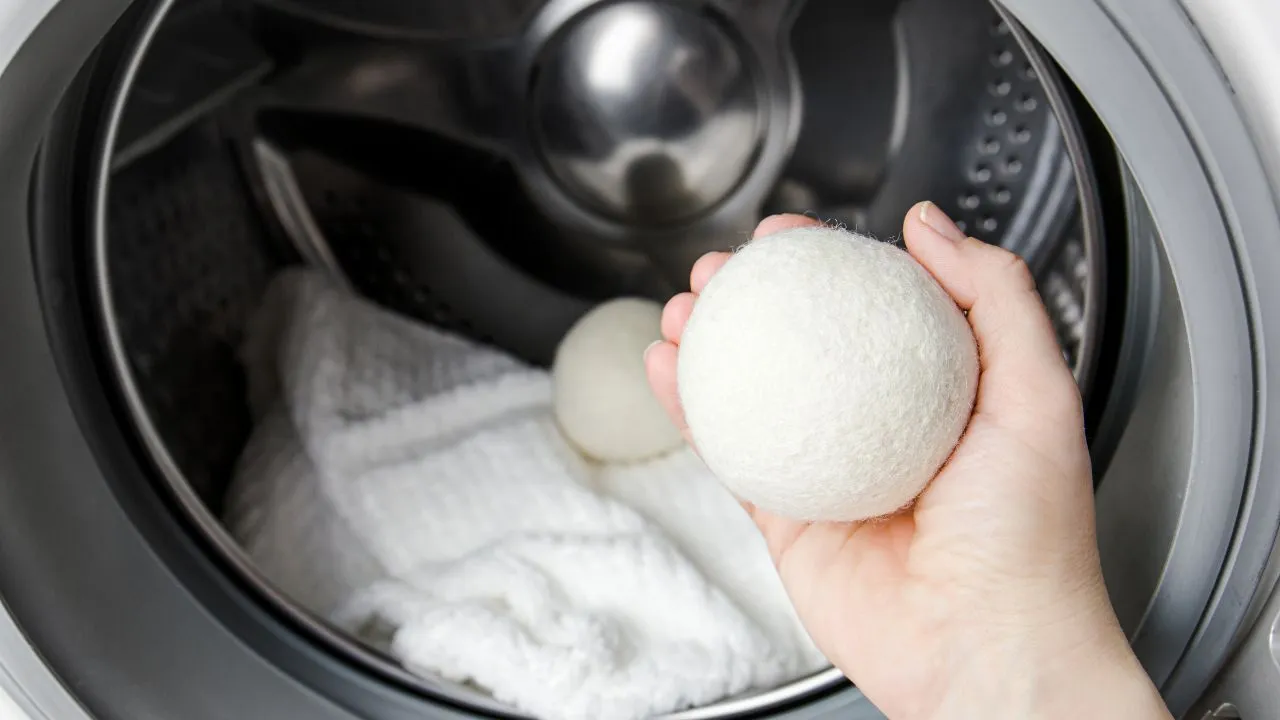It is important to know What To Use Instead Of Tennis Balls In Dryer. Tennis balls are not suitable for delicate or synthetic fabrics. They cause pilling or damage to sensitive clothes. There are several things to use alternatives of tennis balls such as tennis balls being able to bear the heat of some dryer cycles and temperatures. During functioning, they can melt or release chemicals. Tennis balls are very loud in the dryer and may annoy people or disturb their sleep.
We can use sock balls, wool dryer balls, aluminum foil, and plastic dryer balls. Tennis balls are not available on time, and some people can’t buy them only for laundry purposes. Tennis balls may harm sensitive clothes to some extent. So some people don’t prefer tennis balls. They prefer sock balls, stuffed animals, dryer sheets, and old shoes. They prefer such materials because they can avail themselves of them at home. Some people do not have to spend more money on purchasing tennis balls.
Many people use T-shirts, their used shoes, and socks to solve this problem. These materials are natural and reusable. They are eco-friendly and don’t harm or pollute the environment. They prevent clothes from clumping and static cling. We should check the care labels of clothes before using these alternatives. Some clothes need special heat or treatment in the dryer.
Table of Contents
ToggleWhy Use Something in the Dryer?
It’s vital to understand the reasons behind the use of tennis balls and other related items. During drying, some heavy materials like pillows or jackets clump together. This bulky material leads to uneven drying. The use of items like dryer balls keeps the layers separate, and the cloth dries evenly.
The use of balls or other items reduces drying time. They soften the fabrics. They reduce static cling and save energy. They improve the flow of hot air and speed up the drying of clothing.
Best Alternatives of Tennis Balls in dryer
- Wool Dryer Balls
- Aluminum Foil Balls
- Plastic or Rubber Dryer Balls
- Clean, dry towels
- Reusable Sponges Balls
- Small Stuffed Toys (Without Plastic Parts)
1. Wool Dryer Balls: The Eco-Friendly Balls
Wool dryer balls are a natural option instead of tennis balls. They are made from natural wool. These are often designed only for laundry purposes. They prevent wrinkles and static and give fragrance to your laundry. Wool dryer balls bounce off clothes to soften garments. They work best in small to medium loads, so they have space to move around.
Wool dryer balls are natural and biodegradable. We can use them for heavy loads. They not only hold on to heat, but they also aid in keeping clothing apart in the dryer. Allowing for better airflow and a 25% reduction in drying time for each load.
We can prepare it by the following method:
- Form a ball out of the wool yarn or fabric strips.
- To create a spherical shape, wrap it around your fingers and change direction.
- Wrap until a ball the size of a tennis ball is formed.
- Draw a length of wool yarn under the ball’s layers using a large needle or a crochet hook.
- With scissors, cut the end of the yarn off. By doing this, the ball will be held in place and kept from unraveling.
- Continue doing this until you have achieved your desired number of wool balls.
- If you’d like, you can make them in various colors and sizes.
- Each wool ball should be placed inside a pantyhose or old sock, and each ball should be knotted.
- They will maintain their shape better as a result of the felting process.
- Wash the wool balls in hot water and dry them over high heat.
- Repeat these steps two or three times to feel the wool balls.
- When the balls are smooth and solid and the fibers join together prepare felt.
- After removing the wool balls from the pantyhose or socks, enjoy using the wool balls in your dryer.
- If you want to smell your laundry, you can add a few drops of essential oil to the wool balls.

2. Aluminum foil balls: A Simple DIY Solution
Balls made of aluminum foil are an easy and affordable substitute. Crumple up some aluminum foil into a ball the size of a tennis ball. They are thin sheets of metal. Crumpled sheets of metal are tossed in the dryer with wet clothes. You should try aluminum foil instead of Tennis Balls.
They reduce the static cling by neutralizing the electric charge. They prevent your clothes from sticking. They keep the clothes separate in the dryer, promoting better air circulation. They take less drying time. They have some advantages over tennis balls. You can use the aluminum balls for many loads.
Using aluminum foil is safer than tennis balls and dryer sheets. Dryer sheets contain harmful chemicals that may damage your clothes. They are more durable. They have a much lower price than tennis balls. They can’t shed or wear out and don’t pollute the environment. They can’t harm or induce any change in the environment.
3. Plastic or Rubber Dryer Balls: Durable and Effective
These balls are plastic or rubber spheres that aid in drying and softening clothing. Rubber balls or plastic balls are long-lasting and can bear high heat. They function by generating space and movement between the garments. It speeds up the flow of hot air and shortens the drying period. They aid in preventing static cling and wrinkles, leaving clothing more polished. Place 2-3 dryer balls in the dryer with your clothes. These are the steps to use plastic dryer balls in the dryer.
- As normal, load your damp garments into the dryer.
- Depending on the size of the load, place three to six plastic dryer balls inside the dryer.
- For bigger weights or heavier clothes, like trousers or towels, you can use extra balls.
- Turn on the dryer and proceed with the regular cycle.
- Take out the dryer balls and your clothes after the cycle ends.
- Until they need it again, keep the dryer balls somewhere dry.

4. Clean, dry towels: Easy and Cheap Solution
Use clean and dry towels in your dryer load. They will absorb moisture and reduce drying time. When you dry bulky items, towels will help you more. They prevent items from clumping together and keep them separate. Add one or two clean, dry towels to the dryer with your wet laundry. Remove the towels halfway through the drying cycle to prevent over-drying.
Be aware: Avoid using items that could melt, stain, or damage your clothing. Such as plastic or items with sharp edges. Always ensure that the alternative you choose is safe for both your dryer and laundry.
5. Reusable Sponge Balls: Creative and Resourceful
For another DIY option, consider cutting up sponges into small pieces. Fold them into ball shapes to use as tennis balls in dryer substitutes.
- Help with drying by absorbing some moisture and providing gentle agitation.
- Are reusable for several loads.
- It is an eco-friendly option if you’re repurposing old sponges.
6. Small Stuffed Toys (Without Plastic Parts)
Small, soft stuffed toys without any plastic parts can be a good alternative. Stuffed toys are gentle with clothes and do not harm clothes. Take a soft toy without any plastic parts and toss it into the dryer with your laundry.
Conclusion
A lot of people use Tennis Balls In Dryer. Tennis balls reduce wrinkles, fluff up clothes, and prevent static cling in the dryer. Tennis balls are not suitable for delicate or synthetic fabrics. They cause pilling or damage to sensitive clothes. We can use Sock balls, Wool dryer balls, Aluminium foils, and Plastic dryer balls. Tennis balls are not available on time and some people can’t buy them only for laundry purposes. Wool dryer balls are natural alternatives to Tennis Balls In Dryer. They prevent wrinkles and static and give fragrance to your laundry.
We should know What To Use Instead Of Tennis Balls In Dryer. Some people don’t prefer Tennis Balls In Dryer. They prefer Sock balls, Stuffed Animals, Dryer Sheets, and Old Shoes. Sock balls are small and soft balls made from socks. Sock balls are the natural alternatives to Tennis Balls. Dryer sheets contain lubricant and fragrance. Plastic dryer balls function by generating space and movement between the garments. It speeds up the flow of hot air and shortens the drying period.
FAQs
You should use non-toxic dryer ball alternatives and natural dryer ball options. To inform you more, here are important Frequently Asked Questions.
Q: How many dryer balls or alternatives should I use per load?
3-4 wool dryer balls or similar items are recommended for an average-sized load. Use more for heavier loads to promote consistent drying and avoid clumping.
Q: Do environmentally friendly dryer techniques apply to all kinds of laundry?
Yes, most alternatives can be used with various types of laundry. Such as delicates, towels, and bedding. Be careful with delicate fabrics. Always check the first few drying cycles when using a new alternative.
Q: How long do wool dryer balls last compared to tennis balls?
Wool dryer balls have a 1,000-load capacity and are strong. They are long-lasting alternatives to tennis balls. They may wear out or lose effectiveness over time.
Q: Can I add fragrance to my laundry with these alternatives?
Yes, you may add essential oil to wool dryer balls before placing them in the dryer. This will leave your clothes with a pleasant, natural scent.

